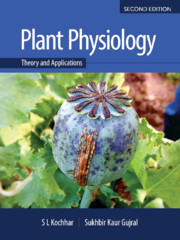Book contents
- Frontmatter
- Contents
- Foreword
- Preface to the Second Edition
- Preface to the First Edition
- Acknowledgements
- Some Common Abbreviations used in the Text
- Abbreviations for Units
- Unit I Water and Mineral Translocation in Plants
- Unit II Metabolism and Bioenergetics
- Unit III Growth and Development
- Unit IV Physiological Stress and Secondary Metabolites – Their Role in Metabolism
- Unit V Crop Physiology – An Innovative Approach
- Unit VI Breakthroughs in Plant Physiology
- Unit VII Some Experimental Exercises
- Glossary
- References
- Index
- Colour Plates
Foreword
Published online by Cambridge University Press: 12 May 2020
- Frontmatter
- Contents
- Foreword
- Preface to the Second Edition
- Preface to the First Edition
- Acknowledgements
- Some Common Abbreviations used in the Text
- Abbreviations for Units
- Unit I Water and Mineral Translocation in Plants
- Unit II Metabolism and Bioenergetics
- Unit III Growth and Development
- Unit IV Physiological Stress and Secondary Metabolites – Their Role in Metabolism
- Unit V Crop Physiology – An Innovative Approach
- Unit VI Breakthroughs in Plant Physiology
- Unit VII Some Experimental Exercises
- Glossary
- References
- Index
- Colour Plates
Summary
Plant Physiology is a rapidly advancing field of study where new findings are surfacing in the literature almost daily. The ways of teaching the subject at both undergraduate and postgraduate levels have undergone a sea change and there is now a far greater emphasis on the conceptual framework than there was some years ago. It has become increasingly difficult for students to keep abreast with the ongoing explosion of knowledge in this field.
This book on Plant Physiology – Theory and Applications is both authoritative and timely. The book focuses on in-depth analysis of wide-ranging topics included in the Plant Physiology syllabi of different universities in India and overseas. The textbook starts with water and concludes with experimental exercises, project works and physiological set-ups or demonstration experiments. The chapters dealing with photosynthesis, respiration, and nitrogen metabolism are important since an understanding of their role for sustaining life on earth is essential for food security and climate resilient farming. Experiments are underway to convert C3 plants like rice into C4 plants in order to improve their photosynthetic efficiency. Researches are underway to transfer nitrogen-fixing genes into cereal crops to lessen our dependence on nitrogenous fertilisers. I am confident that the students going through the book will be stimulated to undertake the innovative experiments which can help to shape the physiological rhythms of plants to the emerging era of global warming and climate change. The material is presented in a concise and lucid manner so that the readers can easily comprehend the conceptual complexities of recent achievements in the field. A discussion of Molecular Mechanism of Abiotic and Biotic Stresses would be of immense help to the students. In view of climate change, the authors have emphasised the concepts of water use efficiency (WUE) and nitrogen use efficiency (NUE). A feature of the book is the inclusion of Review Questions with answers at the end of each chapter. This would be of enormous help to the students preparing for their academic course work.
We are indebted to Dr S. L. Kochhar and Dr Sukhbir Kaur Gujral for their labour of love in presenting the secrets of life to young scholars in an easily understandable manner.
- Type
- Chapter
- Information
- Plant PhysiologyTheory and Applications, pp. xiii - xivPublisher: Cambridge University PressPrint publication year: 2020

